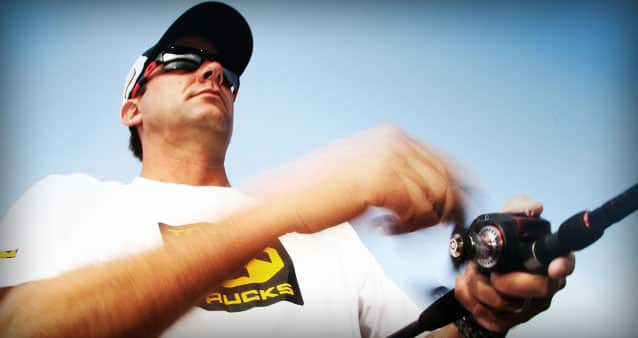KVD on Alternatives to Sight Fishing
Kevin VanDam 05.01.12

If you want to trigger a heated discussion with anglers, bring up the topic of spawning bass.
Many fishermen question the ethics of taking bass from beds or believe it hurts bass populations. Others, including some biologists, claim that Mother Nature can adjust to any losses, and if you’re releasing the fish, it’s no big deal.
I’m not going to try to sway you one way or another.
The good news is that not all bass spawn at the same time on a given lake, so you have a choice. If you don’t want to target bedding bass, you can find other patterns for pre-spawn or post-spawn fish in other areas of the lake.
Here’s why: Fish living in shallower sections, like the upper end of the reservoir or northern bays and shorelines, are the first to spawn. As you move toward the dam or in deeper or clearer waters, the fish spawn later and will be in pre-spawn season while others are spawning. Once the late spawners began to bed, you can rotate to the areas where fish spawned sooner and catch post-spawn fish.
Understand, of course, that if you fish shallow during spring and don’t “sight fish” you’re still going to catch bass off beds.
Even though you can’t see fish bedding due to water clarity, cover or depth, spawners will bite a lure worked over its bed without you intentionally trying to aggravate it into striking. Bass are very territorial during the spring and can be extremely aggressive at times.
If you choose to target bedding bass, there are tricks you can use that will help you be more successful. Fish are aggressive toward natural predators like bluegills and perch that attempt to steal from the nest. Panfish are notorious egg gobblers, so I rely on lure colors that best resemble them even though they may not be appropriate colors for the water clarity. A gaudy bluegill color may be too loud for clear water under normal conditions, but it could trigger strikes when raked over a bass’ bed. Another one of my favorites is a spinnerbait dressed in perch skirt and blade colors.
It’s equally important to fish lures that stay in the strike zone longer. If you’re fishing a crankbait or a spinnerbait, work them slowly along the bottom. A lipless crankbait that is designed to be fished quickly isn’t a good choice while a jerkbait that hovers over the nest would be better. Topwaters that create a noise also are excellent, especially when fishing areas where bass have hatched and the adult is protecting fry.
The fish will tell you if you’re fishing appropriately. I’ve seen times when spawning bass would hammer a spinnerbait one day but wouldn’t take it the next. That’s when you should fish a slower, bulkier bait, like a jig or Texas-rigged lizard, because the fish will mouth the lure to move it off the nest and give you time to set the hook.
Abrupt weather changes or falling water can affect spawning bass and cause them abandon the shallows where you may have caught them the day before. When this happens, back off to the nearest depth change (deeper water) – perhaps a spot where you caught them during pre-spawn – and fish slower. My favorite tactic for that is to fish an unweighted stick worm, like a Strike King Ocho, and let it sink slowly on the edges of cover or drop off. Or, if you need to cover water quickly, drag a Carolina-rigged lizard through those same areas.
Spring is a great period for fishing but you don’t have to pester bedding fish into biting. Simply adjust your tactics and cover more water. You may wind up catching bigger fish than your buddies who prefer to sight fish for spawning bass.

